Gian Lorenzo Bernini (1598-1680) can easily be described as the founding father of Baroque sculpture. He left a permanent mark on the city of Rome as both a Baroque sculptor and architect and is, therefore, one of the most renowned Baroque artists in history.
He was equally talented as both a sculptor and architect and designed multiple famous buildings in Rome, including but not limited to the interior design of St. Peter’s Basilica and St. Peter’s Square.
Apart from the square in front of the biggest church in the world, most of his architectural achievements involved redesigning existing structures.
Because of that, we have compiled a list of the most famous sculptures created by Gian Lorenzo Bernini, the epitome of Baroque sculptures that were created in the 17th century.
1. The Goat Amalthea with the Infant Jupiter and a Faun
- Date created: 1609–1615
- Dimensions: 44 centimeters (17 inches)
- Location: Galleria Borghese, Rome, Italy
The Goat Amalthea with the Infant Jupiter and a Faun is considered to be the earliest known work by Gian Lorenzo Bernini. It’s unsure when exactly he completed it, but it’s certain that he was still in his early teens when it was finished.
Some sources state that it was completed in 1609 when he was just 11 years old, even though it’s pretty certain he created sculptures before this one as well.

2. Neptune and Triton
- Date created: 1622-1623
- Dimensions: 182 centimeters (72 inches)
- Location: Victoria and Albert Museum, London, United Kingdom
Neptune and Triton is another early work by Bernini that he completed in the early 1620s. It was commissioned by Cardinal Alessandro Damascenti-Peretti Montalto and originally served as a fountain that decorated the Cardinal’s Villa Peretti Montalto on the Viminal Hill in Rome.
It was purchased by an Englishman in the 18th century and eventually ended up in the Museum in London after switching hands a couple more times.

3. The Rape of Proserpina
- Date created: 1621-1622
- Dimensions: 225 centimeters (89 inches)
- Location: Galleria Borghese, Rome, Italy
The Rape of Proserpina is another sculpture that was completed in the early 1620s. It depicts the scene when Ancient Roman goddess Proserpina is abducted and taken to the underworld by the god Pluto.

It’s also another sculpture that was commissioned by Cardinal Scipione Borghese and only moved to its current location in the early 20th century.
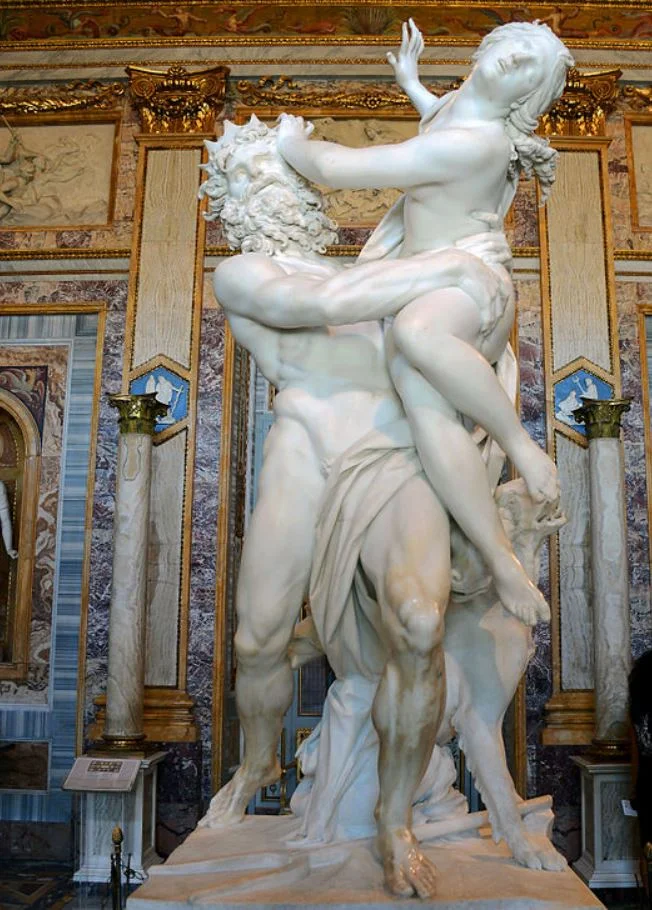
4. Apollo and Daphne
- Date created: 1622-1625
- Dimensions: 243 centimeters (96 inches)
- Location: Galleria Borghese, Rome, Italy
Apollo and Daphne is a sculpture that was completed halfway through the 1620s and was the final of the series of sculptures by the Cardinal Borghese.
It was moved to his Villa as well and was one of the few statues that continued to be kept in high regard after Bernini’s death. This remained during a period that saw the decline of Baroque art in favor of the more sober Neoclassical style.
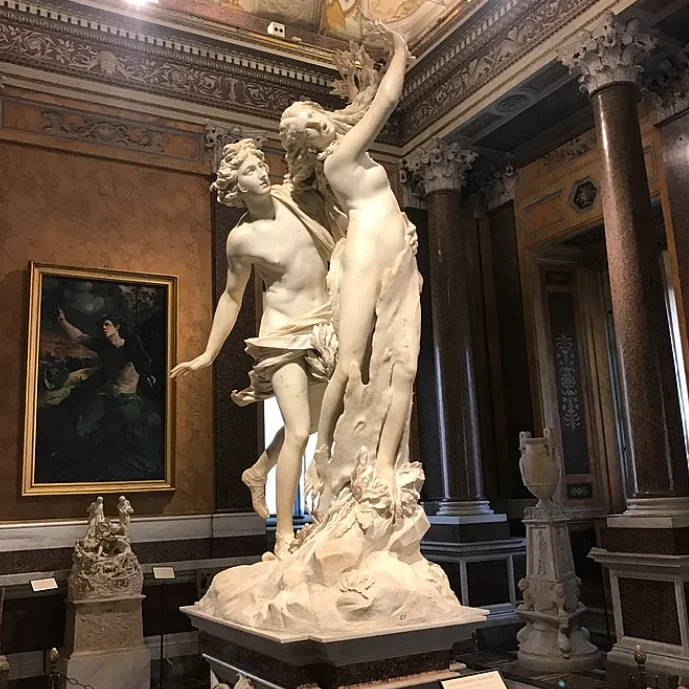
5. David
- Date created: 1623-1624
- Dimensions: 170 centimeters (67 inches)
- Location: Galleria Borghese, Rome, Italy
David by Gian Lorenzo Bernini is one of the countless depictions of the Biblical hero David as he is about to fight Goliath. You will find some of the most famous examples in our list of sculptures by Donatello and sculptures by Michelangelo.
Bernini’s version depicts David as he is about to throw the stone which eventually kills Goliath. This statue was revolutionary at the time because of its sense of movement.
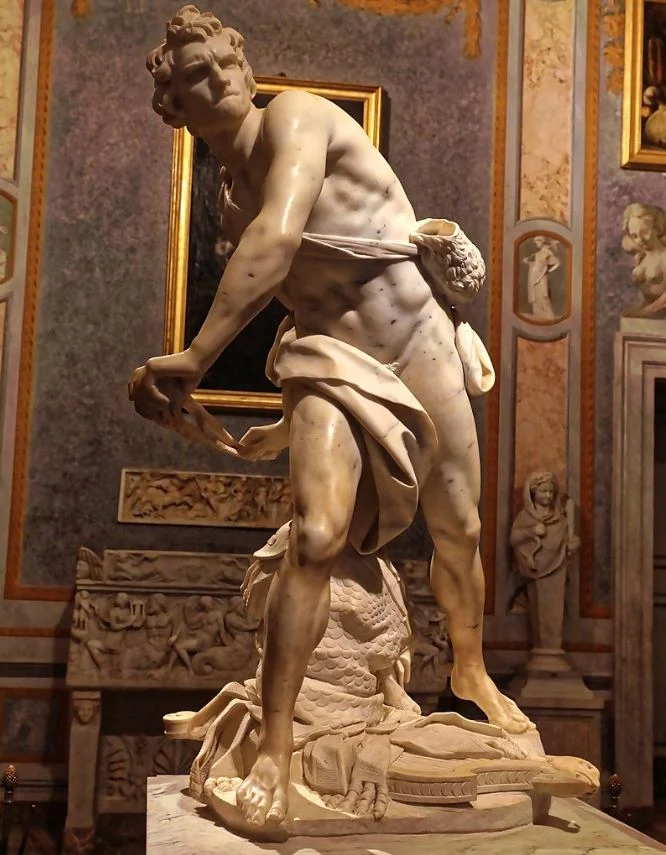
6. St. Peter’s Baldachin
- Date created: 1623-1634
- Dimensions: 28.74 meters (94.3 feet)
- Location: St. Peter’s Basilica, Vatican City
St. Peter’s Baldachin is one of the most iconic works of art created by Bernini. It’s a huge sculpted bronze canopy located over the high altar of St. Peter’s Basilica in Vatican City.
It’s situated directly underneath the dome of the Basilica at the crossing and is one of the most fascinating works of art in the church. With a height of nearly 30 meters, it’s a visual compensation for the immense scale of the interior of the largest church in the world.

7. Corpus
- Date created: 1655
- Dimensions: Life-sized
- Location: Art Gallery of Ontario, Toronto, Canada
Corpus is a sculpture depicting the crucified Jesus Christ and Bernini completed it in the 1650s. What’s remarkable about this work of art is that Bernini kept onto it for about 25 years, meaning it’s a work he created for his own personal collection.
It has been valued at $50 million in 2007 and was donated to the Art Gallery of Ontario in Toronto, a pretty amazing gift! It’s considered to be a long-lost masterpiece of the artist because it was only in 2004 that it was revealed he created it and not an unknown French artist.

8. Ecstasy of Saint Teresa
- Date created: 1647-1652
- Dimensions: Life-sized
- Location: Santa Maria della Vittoria, Rome, Italy
The Ecstasy of Saint Theresa depicts the 16th-century Spanish Saint Theresa, a noblewoman who became a Carmelite nun. It’s located in the Cornaro Chapel of Santa Maria della Vittoria in Rome, a building of which most of the interior was also designed by Gian Lorenzo Bernini.
This sculpture is considered to be one of the absolute masterpieces of Roman Baroque art. It’s illuminated by natural light which enters the dome of the building.
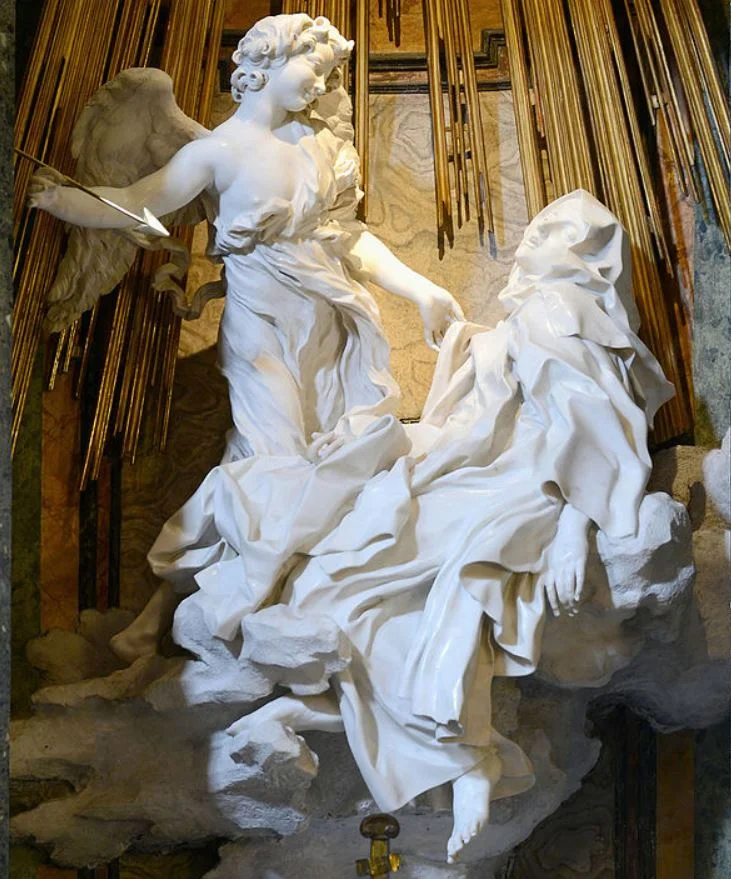
9. Chair of Saint Peter
- Date created: 1657–1666
- Dimensions: 15 meters (49 feet)
- Location: St. Peter’s Basilica, Vatican City
The Chair of Saint Peter is another monumental work of art by Gian Lorenzo Bernini which is located in Saint Peter’s Basilica in Vatican City.
The decorations added by Bernini were created around the relic, which is a wooden chair believed to have been used by Saint Peter, one of the 12 Apostles of Jesus Christ and leader of the early Christians, as well as the first Bishop of Rome. Multiple studies have concluded, however, that this chair dates back to the 6th century.

10. Elephant and Obelisk
- Date created: 1666-1667
- Dimensions: 12.69 meters (41 feet)
- Location: Piazza della Minerva, Rome, Italy
Elephant and Obelisk is a statue located on the Piazza della Minerva, a square situated near the Pantheon, one of the most magnificent temples built in Ancient Rome.
It depicts an elephant carrying an obelisk, a monument that was discovered in 1655 when excavations took place to build the nearby church. With a height of just over 5 meters, it’s the smallest of the 13 ancient obelisks present in Rome today.
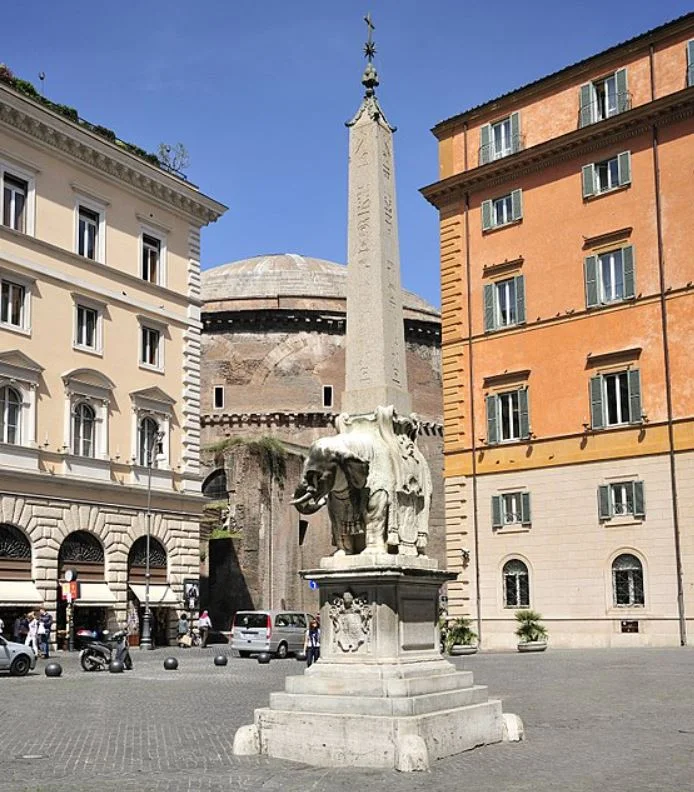
11. Blessed Ludovica Albertoni
- Date created: 1671–1674
- Dimensions: Just over life-sized
- Location: Church of San Francesco a Ripa, Rome, Italy
Blessed Ludovica Albertoni is a funerary monument dedicated to Ludovica Albertoni, a Roman noblewoman who entered the Third Order of St. Francis after her husband died and she sacrificed her life to support the poor.
The monument is located in a specially designed chapel in one of Rome’s many churches called the San Francesco a Ripa.
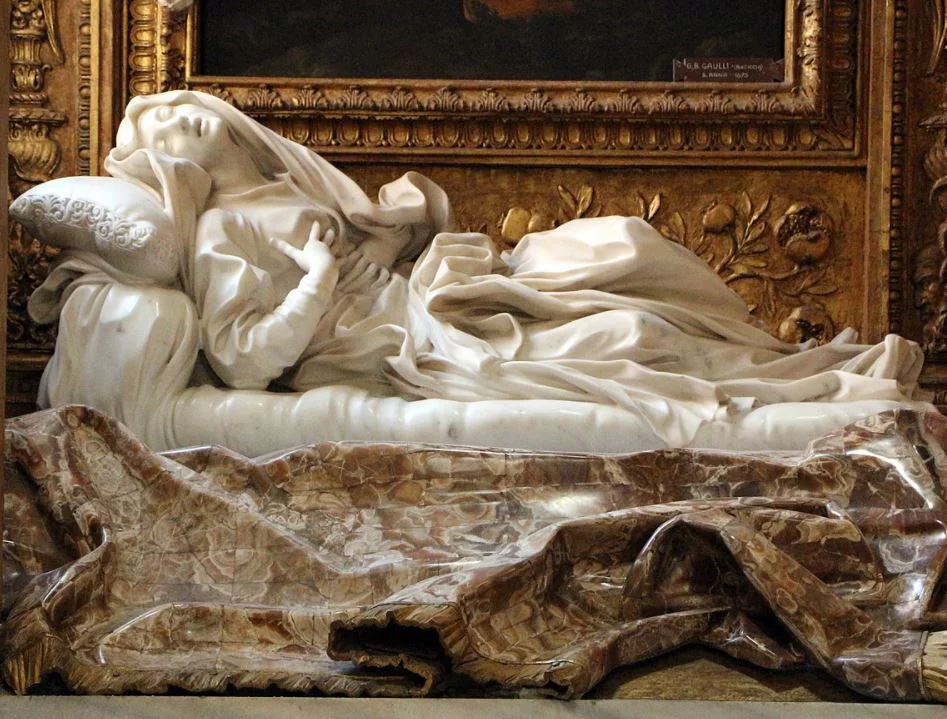
12. Bust of Louis XIV
- Date created: 1665
- Dimensions: 80 centimeters (31 inches)
- Location: Palace of Versailles, Versailles, France
The Bust of Louis XIV depicts a way less humble man, French King Louis XIV, famously known for building the epitome of palaces at Versailles.
It was commissioned by the King of France during one of Bernini’s visits to the country, emphasizing the fact that his reputation had spread across the borders of Italy. By this time, he was one of the most renowned artists in Europe which effectively makes him one of the most famous Baroque artists in history!
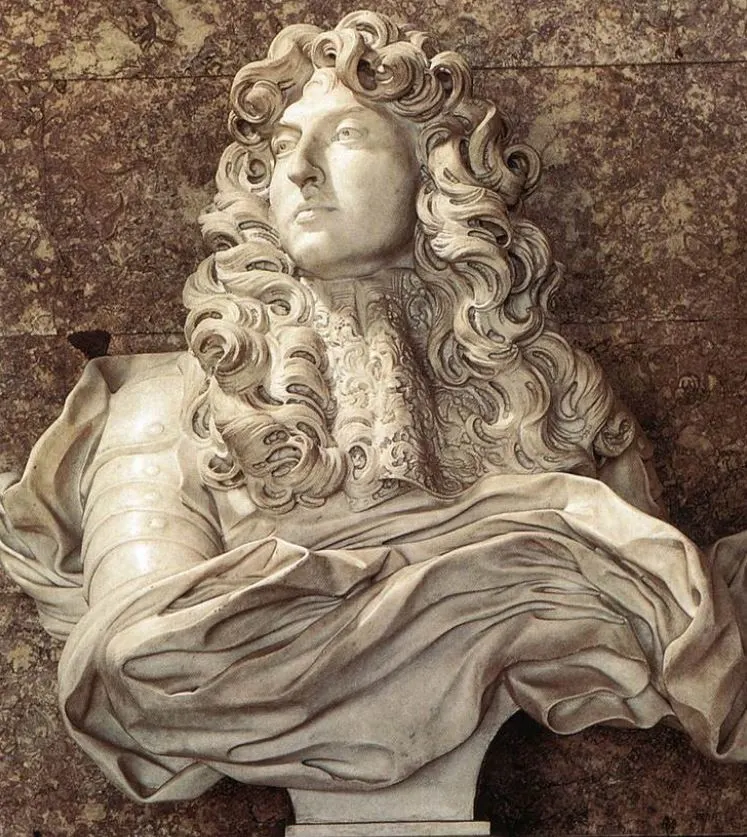
13. Bust of Pope Gregory XV
- Date created: 1621
- Dimensions: 83.2 × 62.3 × 32.4 centimeters (32.75 × 24.5 × 12.75 inches)
- Location: Art Gallery of Ontario, Toronto, Canada
The Bust of Pope Gregory XV was commissioned by the newly-elected pope in February of the year 1621 and Bernini completed it in September of that year. It depicts the aging man with an alert gaze in the typically naturalistic style of Bernini’s early years.
The sculpture was loved by the Pope who awarded the young artist with a knighthood referred to as the “Supreme Order of Christ.” This was a great recognition for the aspiring artist who was only at the start of his long career when he carved this magnificent work of art.

14. Truth Unveiled by Time
- Date created: 1645-1652
- Dimensions: 277 centimeters (109 inches)
- Location: Galleria Borghese, Rome, Italy
Truth Unveiled by Time is the title of one of the few Bernini sculptures that weren’t commissioned by a patron. The artist’s career suffered a major blow when his major patron, Pope Urban VIII, died, and he was blamed for the cracks in the bell towers that he designed for St. Peter’s Basilica.
He started working on this sculpture to make a statement as it depicts an allegory of truth that is being unveiled by time. Unfortunately, he never managed to add the allegory of time and left the sculpture unfinished in 1652. So how did this story end? He was eventually exonerated for that fiasco at the end of his life.
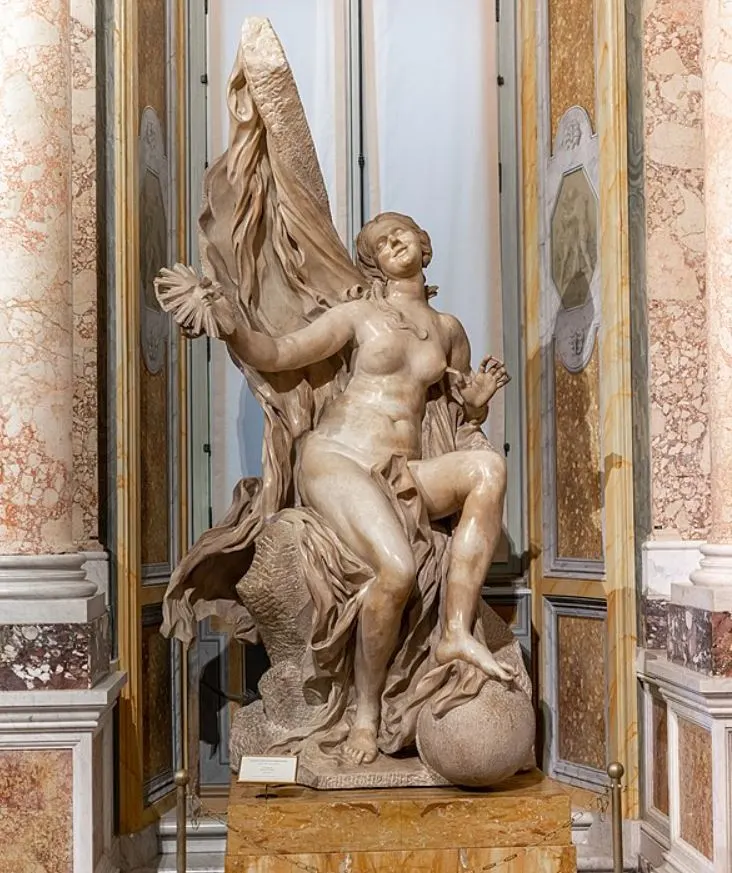

Leave a comment
You must be logged in to post a comment.